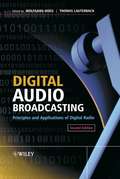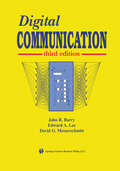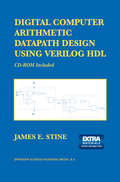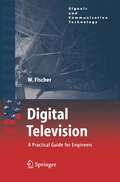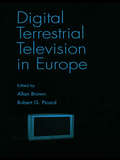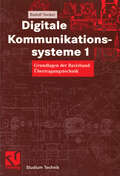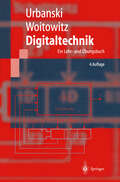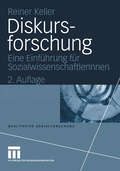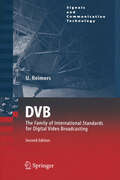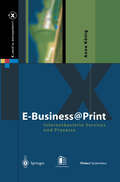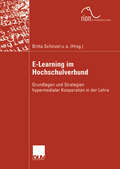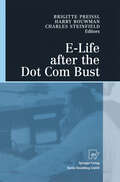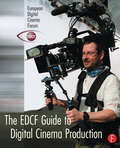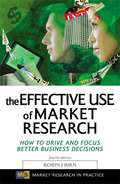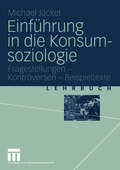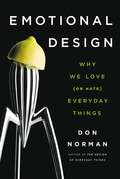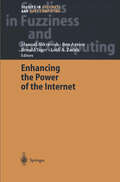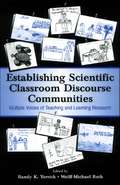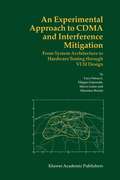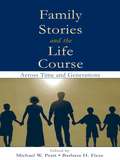- Table View
- List View
Digital Audio Broadcasting: Principles and Applications of Digital Radio
by Wolfgang Hoeg Thomas LauterbachNow the standardisation work of DAB (Digital Audio Broadcasting) system is finished many broadcast organisations, network providers and receiver manufacturers in European countries and outside of Europe (for example Canada and the Far East) will be installing DAB broadcast services as pilot projects or public services. In addition some value added services (data and video services) are under development or have already started as pilot projects. The new digital broadcast system DAB distinguishes itself from existing conventional broadcast systems, and the various new international standards and related documents (from ITU-R, ISO/IEC, ETSI, EBU, EUREKA147, and others) are not readily available and are difficult to read for users. Therefore it is essential that a well structured technical handbook should be available. The Second Edition of Digital Audio Broadcasting has been fully updated with new sections and chapters added to reflect all the latest developments and advances. Digital Audio Broadcasting: Provides a fully updated comprehensive overview of DAB Covers international standards, applications and other technical issues Combines the expertise of leading researchers in the field of DAB Now covers such new areas as: IP-Tunneling via DAB; Electronic Programme Guide for DAB; and Metadata A comprehensive overview of DAB specifically written for planning and system engineers, developers for professional and domestic equipment manufacturers, service providers, as well as postgraduate students and lecturers in communications technology.
Digital Communication
by John R. Barry Edward A. Lee David G. MesserschmittThis book concerns digital communication. Specifically, we treat the transport of bit streams from one geographical location to another over various physical media, such as wire pairs, coaxial cable, optical fiber, and radio. We also treat multiple-access channels, where there are potentially multiple transmitters and receivers sharing a common medium. Ten years have elapsed since the Second Edition, and there have been remarkable advances in wireless communication, including cellular telephony and wireless local-area networks. This Third Edition expands treatment of communication theories underlying wireless, and especially advanced techniques involving multiple antennas, which tum the traditional single-input single-output channel into a multiple-input multiple-output (MIMO) channel. This is more than a trivial advance, as it stimulates many advanced techniques such as adaptive antennas and coding techniques that take advantage of space as well as time. This is reflected in the addition of two new chapters, one on the theory of MIMO channels, and the other on diversity techniques for mitigating fading. The field of error-control coding has similarly undergone tremendous changes in the past decade, brought on by the invention of turbo codes in 1993 and the subsequent rediscovery of Gallager's low-density parity-check codes. Our treatment of error-control coding has been rewritten to reflect the current state of the art. Other materials have been reorganized and reworked, and three chapters from the previous edition have been moved to the book's Web site to make room.
Digital Computer Arithmetic Datapath Design Using Verilog HDL
by James E. StineThe role of arithmetic in datapath design in VLSI design has been increasing in importance over the last several years due to the demand for processors that are smaller, faster, and dissipate less power. Unfortunately, this means that many of these datapaths will be complex both algorithmically and circuit wise. As the complexity of the chips increases, less importance will be placed on understanding how a particular arithmetic datapath design is implemented and more importance will be given to when a product will be placed on the market. This is because many tools that are available today, are automated to help the digital system designer maximize their efficiently. Unfortunately, this may lead to problems when implementing particular datapaths. The design of high-performance architectures is becoming more compli cated because the level of integration that is capable for many of these chips is in the billions. Many engineers rely heavily on software tools to optimize their work, therefore, as designs are getting more complex less understanding is going into a particular implementation because it can be generated automati cally. Although software tools are a highly valuable asset to designer, the value of these tools does not diminish the importance of understanding datapath ele ments. Therefore, a digital system designer should be aware of how algorithms can be implemented for datapath elements. Unfortunately, due to the complex ity of some of these algorithms, it is sometimes difficult to understand how a particular algorithm is implemented without seeing the actual code.
Digital Television: A Practical Guide for Engineers (Signals and Communication Technology)
by Walter FischerDigital Television closely examines all present-day TV transmission methods. These include MPEG, DVB, ATSC and ISDB-T. DVD is also discussed. The text covers these subjects in a practical-minded manner. Although mathematical formulations are used, they are in most cases only utilized to supplement the text. The book also contains chapters dealing with basic concepts such as digital modulation or transformations into the frequency domain. A major emphasis is placed on the measuring techniques used on these various digital TV signals. Practical examples and hints concerning measurement are provided. The book starts with analog TV base and signal, continues with MPEG-2 data stream, digital video, and digital audio, and then moves on to compression methods. After an excursion into the digital modulation methods, all the mentioned transmission methods are discussed in detail.
Digital Terrestrial Television in Europe
by Allan Brown Robert G. PicardDigital technology for the production, transmission, and reception of television is expected to replace analogue transmission throughout the world. The timetable for this transition is uncertain and different projections have been made for virtually every country in the world. This book gives the exhaustive details of the issues of this changeover in Europe and elsewhere. The details are placed within the context of the massive changes, which the television industry has been subjected to over the past 25 years.The rollout of digital terrestrial television (DTTV) in Europe is a significant issue for every country included in this survey. It is of such importance because DTTV is the centerpiece of many governments' policies toward making Europe the world leader in new information and communication technologies. These same governments are all wrestling with the issues of how to use the technology in ways that create both commercial and non-commercial value. European perspectives on the social, cultural, and political nature of broadcasting vary significantly from those in other parts of the world and require that the introduction of DTTV should be handled differently to its introduction elsewhere.There are enormous technical, political, and economic aspects to be considered and these vary from country to country in Europe. The two editors bring a perspective to this study as media economists who come to the European scene from other parts of the world. The book covers DTTV in depth, and it also includes discussions of cable, satellite, broadband, and Internet technology for comparison.
Digital Terrestrial Television in Europe
by Allan Brown Robert G. PicardDigital technology for the production, transmission, and reception of television is expected to replace analogue transmission throughout the world. The timetable for this transition is uncertain and different projections have been made for virtually every country in the world. This book gives the exhaustive details of the issues of this changeover in Europe and elsewhere. The details are placed within the context of the massive changes, which the television industry has been subjected to over the past 25 years.The rollout of digital terrestrial television (DTTV) in Europe is a significant issue for every country included in this survey. It is of such importance because DTTV is the centerpiece of many governments' policies toward making Europe the world leader in new information and communication technologies. These same governments are all wrestling with the issues of how to use the technology in ways that create both commercial and non-commercial value. European perspectives on the social, cultural, and political nature of broadcasting vary significantly from those in other parts of the world and require that the introduction of DTTV should be handled differently to its introduction elsewhere.There are enormous technical, political, and economic aspects to be considered and these vary from country to country in Europe. The two editors bring a perspective to this study as media economists who come to the European scene from other parts of the world. The book covers DTTV in depth, and it also includes discussions of cable, satellite, broadband, and Internet technology for comparison.
Digitale Kommunikationssysteme 1: Grundlagen der Basisband-Übertragungstechnik (Studium Technik)
by Rudolf NockerIn diesem Lehr- und Übungsbuch werden anschaulich die Grundlagen der digitalen Übertragungstechnik kurz und prägnant behandelt. Dabei wird ein Schwerpunkt auf die Basisband-Übertragungstechnik gelegt. Die grundlegenden Begriffe der Quellen-, Kanal- und Leitungscodierung werden anschaulich dargestellt und können vom Leser abgeleitet werden. Auf spezielle Detailbetrachtungen wird bewusst verzichtet. Am Ende eines jeden Abschnitts ermöglichen Fragen zum behandelten Stoff die Selbstkontrolle.
Digitaltechnik: Ein Lehr- und Übungsbuch (Springer-Lehrbuch)
by Klaus Urbanski Roland WoitowitzVerständliche, moderne Einführung jetzt in 5., aktualisierter Auflage: Die Autoren verwenden zahlreiche Beispiele und Übungen mit ausführlichen Lösungen. Die Website bietet zusätzliche Übungen, Beiblätter, VHDL-Modelle, Assembler- und C-Programme zum Download.
Diskursforschung: Eine Einführung für Sozialwissenschaftlerlnnen (Qualitative Sozialforschung #14)
by Reiner KellerDas Buch gibt im ersten Teil einen interdisziplinären Überblick über den aktuellen Stand der Diskursforschung und erläutert die wichtigsten diskurstheoretischen Grundlagen. Im zweiten Teil wird das forschungspraktische Vorgehen bei sozialwissenschaftlichen Diskursanalysen - von der Entwicklung der Fragestellung über die Auswahl von Daten, deren Analyse bis hin zur Interpretation und Präsentation der Ergebnisse - detailliert beschrieben. Mit seiner didaktisch aufbereiteten Darstellung wendet sich das Buch an Studierende und Lehrende der Soziologie, der Politik- und Geschichtswissenschaften und angrenzender Disziplinen, die sich im Rahmen der Methodenausbildung, von Studienprojekten und Abschlussarbeiten mit Diskurskonzepten auseinandersetzen wollen sowie allgemein an SozialwissenschaftlerInnen, die bezüglich der Konzeption und Durchführung eigener Forschungsvorhaben an Grundlagen und Umsetzungsmöglichkeiten der Diskursforschung interessiert sind.
DVB: The Family of International Standards for Digital Video Broadcasting (Signals and Communication Technology)
by Ulrich ReimersThis second edition provides first-hand information about the most recent developments in the exciting and fast moving field of telecommunications media and consumer electronics. The DVB group developed the standards which are being used in Europe, Australia, Southeast Asia, and many other parts of the world. Some 150 major TV broadcasting companies as well as suppliers for technical equipment are members of the project. This standard is expected to be accepted for worldwide digital HDTV broadcasting. This book is readable for non-experts with a background in analog transmission, and demonstrates the fascinating possibilities of digital technology. For the second edition, the complete text has been up-dated thoroughly. The latest DVB standards are included in three new sections on Interactive Television, Data Broadcasting, and The Multimedia Home Platform.
E-Business@Print: Internetbasierte Services und Prozesse (X.media.management)
by Anne KönigFür die Printmedienunternehmen haben sich durch das Internet neue Geschäftsfelder eröffnet: Informationen werden sowohl für die Papier- als auch für die Onlineausgabe aufbereitet. Neue Möglichkeiten in der Zusammenarbeit mit Kunden und Produktionspartnern entstehen. Der Leser erhält einen umfassenden Überblick über die neuen Produkte und Prozesse und wird systematisch durch die Begriffsvielfalt geführt; zahlreiche Beispiele veranschaulichen die Anwendungen wie Online-Editiersysteme, webbasierte Projektmanagementtools oder Online-Tracking von Druckaufträgen. Das Thema wird aus zwei Blickwinkeln betrachtet: dem des Unternehmens, das E-Business zur Verbesserung der eigenen Prozesse nutzt, und dem des Printmediendienstleisters, der E-Business-Services für seine Kunden bereitstellt und im Produktionsprozess nutzt. Das Buch liefert Entscheidungshilfen, welche Anwendungen für betriebliche Fragestellungen den größtmöglichen Nutzen versprechen. Ein unentbehrliches Nachschlagewerk für Entscheidungsträger.
E-Learning im Hochschulverbund: Grundlagen und Strategien hypermedialer Kooperation in der Lehre (Informatik)
by Britta Schinzel Jürgen Taeger Peter Gorny Thomas Dreier Bernd HolznagelAusgehend von einer kritischen Analyse der Grundlagen hypermedial ergänzten Lehrens und Lernens und deren Beziehung zu Fragen der Hochschulorganisation illustriert der vorliegende Band die kontextsensitive Entwicklung von mediendidaktischen Szenarien.
E-Life after the Dot Com Bust
by Brigitte Preissl Harry Bouwman Charles SteinfieldAfter the dramatic failures of the dot coms in 2000 and 2001, many observers were quick to report on the death of electronic commerce. Investor confidence sagged, stock prices of technology firms in nearly all of the related sectors suffered. In reality, the picture is not nearly as dismal as the press would have us believe. E-commerce is not dead, but it has moved beyond its overhyped beginning stage. This book is an effort to sort through the hype, providing a realistic assessment of the state of electronic commerce today, and the important areas of opportunity and challenge for tomorrow. The book sees all kind of developments where e-business is becoming an integral part of ‘traditional’ business processes, with special emphasis on practical and policy importance. E-commerce scholars from a number of disciplines and countries contribute to assess the impact of the dot com bust and the current state of e-commerce.
The EDCF Guide to Digital Cinema Production
by Lasse SvanbergA professional introduction to the end-to-end process of digital filmmaking!The EDCF Guide to Digital Cinema Production sheds light on the ongoing and confusing transition from analog to digital technology in film production. In addition to a complete analysis of technical concerns, this text deals with a number of issues where European and Hollywood priorities differ. It adds fuel to the discussion on "Photo-Chemical Fundamentalism" and the future of traditional film-based cinematography.With special emphasis on new HD production techniques for the big cinema screen, this guide is the one and only resource available from a European perspective. The EDCF Guide to Digital Cinema Production provides film professionals and decisions-makers in European cinema with an excellent basis for discussions on how to handle the transition from analog to digital technology. Look no further for:* Several production case studies, among them Ingmar Bergman's last film "Saraband" (2003) and Lars von Trier's "Dogville" (2003).* Surveys of HD Systems & Cameras and "The 37 MFAQ on HD Production."* Expert reports on Audio Recording for HD and the Digital Intermediate Process.* Detailed European initiatives in Digital Cinema.* An up-to-date survey of the problematic standards situation for Digital Cinema.* A comprehensive look at archiving - the "Achilles Heel" of digital production.* The pros and cons of producing feature films digitally - a unique and professional view of "the agony and ecstacy."Editor-in-Chief Lasse Svanberg is a founding member of EDCF. He was DoP on 14 feature films 1966-81, founded TM (Technolgy & Man) Magazine at the Swedish Film Institute in 1968 and was its Chief Editor until 1998 He was elected Fellow of BKSTS 1979, Fellow of SMPTE 1995 and granted Professor's title by the Swedish Government 2002. He is the author of six books on the history and possible future of film, video and television.The European Digital Digital Cinema Forum (EDCF) was constituted in June 2001 as joint Swedish-British-French effort to establish a European forum for discussions, information exchange and industrial activities in the field of Digital Cinema. This project was initiated because digital production, digital distribution and digital exhibition of film is the most radical technical change facing the film industry since sound film was introduced.
The EDCF Guide to Digital Cinema Production
by Lars SvanbergA professional introduction to the end-to-end process of digital filmmaking!The EDCF Guide to Digital Cinema Production sheds light on the ongoing and confusing transition from analog to digital technology in film production. In addition to a complete analysis of technical concerns, this text deals with a number of issues where European and Hollywood priorities differ. It adds fuel to the discussion on "Photo-Chemical Fundamentalism" and the future of traditional film-based cinematography.With special emphasis on new HD production techniques for the big cinema screen, this guide is the one and only resource available from a European perspective. The EDCF Guide to Digital Cinema Production provides film professionals and decisions-makers in European cinema with an excellent basis for discussions on how to handle the transition from analog to digital technology. Look no further for:* Several production case studies, among them Ingmar Bergman's last film "Saraband" (2003) and Lars von Trier's "Dogville" (2003).* Surveys of HD Systems & Cameras and "The 37 MFAQ on HD Production."* Expert reports on Audio Recording for HD and the Digital Intermediate Process.* Detailed European initiatives in Digital Cinema.* An up-to-date survey of the problematic standards situation for Digital Cinema.* A comprehensive look at archiving - the "Achilles Heel" of digital production.* The pros and cons of producing feature films digitally - a unique and professional view of "the agony and ecstacy."Editor-in-Chief Lasse Svanberg is a founding member of EDCF. He was DoP on 14 feature films 1966-81, founded TM (Technolgy & Man) Magazine at the Swedish Film Institute in 1968 and was its Chief Editor until 1998 He was elected Fellow of BKSTS 1979, Fellow of SMPTE 1995 and granted Professor's title by the Swedish Government 2002. He is the author of six books on the history and possible future of film, video and television.The European Digital Digital Cinema Forum (EDCF) was constituted in June 2001 as joint Swedish-British-French effort to establish a European forum for discussions, information exchange and industrial activities in the field of Digital Cinema. This project was initiated because digital production, digital distribution and digital exhibition of film is the most radical technical change facing the film industry since sound film was introduced.
The Effective Use of Market Research: Volume 4 (4th edition) (PDF)
by Robin BirnMore and more companies today are using market research techniques, not just to find new markets, products and customers, but also to improve management and marketing decision making and to monitor customer service. The Effective Use of Market Research looks at the circumstances in which market research is necessary, and explains what management can expect to gain from research and then analyses the type of business decisions that may be taken as a result. An organization that knows its customers and monitors its activity well, and also has a good understanding of the key research techniques it needs, is likely to develop more competitive sales, marketing and communications strategies.This latest edition of Effective Use of Market Research explains how to develop representative samples, data protection legislation and the professional ethics incorporated in the MRS Code of Conduct.
Einführung in die Konsumsoziologie: Fragestellungen - Kontroversen - Beispieltexte
by Michael JäckelDie moderne Gesellschaft lässt sich als Konsumgesellschaft beschreiben. Mode, Geschmack, Stil sind ebenso prägend wie die mit der entstehenden Konsumgesellschaft einhergehende Konsumkritik. Dieses einführende Lehrbuch beschreibt daher die Entstehung und Entwicklung von Konsum und seine gesellschaftliche Bedeutung.
Emotional Design: Why We Love (or Hate) Everyday Things
by Don NormanWhy attractive things work better and other crucial insights into human-centered designEmotions are inseparable from how we humans think, choose, and act. In Emotional Design, cognitive scientist Don Norman shows how the principles of human psychology apply to the invention and design of new technologies and products. In The Design of Everyday Things, Norman made the definitive case for human-centered design, showing that good design demanded that the user's must take precedence over a designer's aesthetic if anything, from light switches to airplanes, was going to work as the user needed. In this book, he takes his thinking several steps farther, showing that successful design must incorporate not just what users need, but must address our minds by attending to our visceral reactions, to our behavioral choices, and to the stories we want the things in our lives to tell others about ourselves. Good human-centered design isn't just about making effective tools that are straightforward to use; it's about making affective tools that mesh well with our emotions and help us express our identities and support our social lives. From roller coasters to robots, sports cars to smart phones, attractive things work better. Whether designer or consumer, user or inventor, this book is the definitive guide to making Norman's insights work for you.
Enhancing the Power of the Internet (Studies in Fuzziness and Soft Computing #139)
by Ben Azvine Ronald R. Yager Lofti A. Zadeh Masoud NikraveshThis book presents reports from the forefront of soft computing in the Internet industry and covers important topics in the field such as search engines, fuzzy query, decision analysis and support systems as well as e-business and e-commerce.
Establishing Scientific Classroom Discourse Communities: Multiple Voices of Teaching and Learning Research
by Randy K. Yerrick Wolff-Michael RothEstablishing Scientific Classroom Discourse Communities: Multiple Voices of Teaching and Learning Research is designed to encourage discussion of issues surrounding the reform of classroom science discourse among teachers, teacher educators, and researchers. The contributors--some of the top educational researchers, linguists, and science educators in the world--represent a variety of perspectives pertaining to teaching, assessment, research, learning, and reform. As a whole the book explores the variety, complexity, and interconnectivity of issues associated with changing classroom learning communities and transforming science classroom discourse to be more representative of the discourse of scientific communities. The intent is to expand debate among educators regarding what constitutes exemplary scientific speaking, thinking, and acting. This book is unparalleled in discussing current reform issues from sociolinguistic and sociocultural perspectives. The need for a revised perspective on enduring science teaching and learning issues is established and a theoretical framework and methodology for interpreting the critique of classroom and science discourses is presented. To model and scaffold this ongoing debate, each chapter is followed by a "metalogue" in which the chapter authors and volume editors critique the issues traversed in the chapter by opening up the neatly argued issues. These "metalogues" challenge, extend, and deepen the arguments made. Central questions addressed include: *Why is a sociolinguistic interpretation essential in examining science education reform? *What are key similarities and differences between classroom and scientific communities? *How can the utility of common knowledge and existing classroom discourse be balanced toward alternative outcomes? *What curricular issues are associated with transforming classroom talk? *What other perspectives can assist in creating multiple access to science through redefining classroom discourse? Whether this volume improves readers' science teaching, assists their research, or helps them to better prepare tomorrow's science teachers, the goal is to engage them in considering the challenges faced by educators as they navigate the seas of reform and strive to improve science education for all.
Establishing Scientific Classroom Discourse Communities: Multiple Voices of Teaching and Learning Research
by Randy Yerrick Wolff-Michael RothEstablishing Scientific Classroom Discourse Communities: Multiple Voices of Teaching and Learning Research is designed to encourage discussion of issues surrounding the reform of classroom science discourse among teachers, teacher educators, and researchers. The contributors--some of the top educational researchers, linguists, and science educators in the world--represent a variety of perspectives pertaining to teaching, assessment, research, learning, and reform. As a whole the book explores the variety, complexity, and interconnectivity of issues associated with changing classroom learning communities and transforming science classroom discourse to be more representative of the discourse of scientific communities. The intent is to expand debate among educators regarding what constitutes exemplary scientific speaking, thinking, and acting. This book is unparalleled in discussing current reform issues from sociolinguistic and sociocultural perspectives. The need for a revised perspective on enduring science teaching and learning issues is established and a theoretical framework and methodology for interpreting the critique of classroom and science discourses is presented. To model and scaffold this ongoing debate, each chapter is followed by a "metalogue" in which the chapter authors and volume editors critique the issues traversed in the chapter by opening up the neatly argued issues. These "metalogues" challenge, extend, and deepen the arguments made. Central questions addressed include: *Why is a sociolinguistic interpretation essential in examining science education reform? *What are key similarities and differences between classroom and scientific communities? *How can the utility of common knowledge and existing classroom discourse be balanced toward alternative outcomes? *What curricular issues are associated with transforming classroom talk? *What other perspectives can assist in creating multiple access to science through redefining classroom discourse? Whether this volume improves readers' science teaching, assists their research, or helps them to better prepare tomorrow's science teachers, the goal is to engage them in considering the challenges faced by educators as they navigate the seas of reform and strive to improve science education for all.
Evidence-Based Treatment of Stuttering: Empirical Bases and Clinical Applications
by Anne K. BotheThis book is the result of a "State-of-the-Art-Conference" held at the University of Georgia dedicated to the evidence-based treatment of stuttering. An international group of prominent fluency researchers and clinicians were invited to present and discuss current data and issues related to the treatment of stuttering. The topic was defined to include evidence about stuttering, evidence about stuttering treatment, and discussions of how that evidence should guide the continuing research and practice. The explicit link between empirical evidence and suggestions for clinical practice is the goal of the book. The book begins by addressing the notion of "evidence-based practice" and considers its implications for stuttering treatment. Part II presents the intersection of the nature of stuttering; the theories of stuttering; and the implications of nature, theory, and other knowledge for stuttering treatment decisions. Part III provides two of the many measurement issues facing stuttering treatment followed by Part IV, which is devoted to the quality of treatment research evidence, for specific treatments and in terms of some more general methodological and professional issues. The final part summarizes the clinical recommendations made throughout the book and discusses evidence-based, outcomes-focused clinical decisions for stuttering. These chapters are intended to provide "state-of-the-art" information to researchers, clinicians, and students who are interested in developing, identifying, or using the best possible evidence-based treatments for stuttering.
Evidence-Based Treatment of Stuttering: Empirical Bases and Clinical Applications
by Anne K. BotheThis book is the result of a "State-of-the-Art-Conference" held at the University of Georgia dedicated to the evidence-based treatment of stuttering. An international group of prominent fluency researchers and clinicians were invited to present and discuss current data and issues related to the treatment of stuttering. The topic was defined to include evidence about stuttering, evidence about stuttering treatment, and discussions of how that evidence should guide the continuing research and practice. The explicit link between empirical evidence and suggestions for clinical practice is the goal of the book. The book begins by addressing the notion of "evidence-based practice" and considers its implications for stuttering treatment. Part II presents the intersection of the nature of stuttering; the theories of stuttering; and the implications of nature, theory, and other knowledge for stuttering treatment decisions. Part III provides two of the many measurement issues facing stuttering treatment followed by Part IV, which is devoted to the quality of treatment research evidence, for specific treatments and in terms of some more general methodological and professional issues. The final part summarizes the clinical recommendations made throughout the book and discusses evidence-based, outcomes-focused clinical decisions for stuttering. These chapters are intended to provide "state-of-the-art" information to researchers, clinicians, and students who are interested in developing, identifying, or using the best possible evidence-based treatments for stuttering.
An Experimental Approach to CDMA and Interference Mitigation: From System Architecture to Hardware Testing through VLSI Design
by Luca Fanucci Marco Luise Filippo Giannetti Massimo RoviniAn Experimental Approach to CDMA and Interference Mitigation was written with the admittedly ambitious intent of filling the gap between communication theory and VLSI implementation, and thus to provide a more general/theoretical approach to the design, development, and testing of a CDMA receiver. As a consequence, the concepts and techniques that are presented turn out to be applicable to a more general kind of digital wireless modems in terms of receiver architecture design and implementation. As the reader will easily find out, the subject of digital modem design and implementation is addressed in the book starting from a theoretical approach (supported by proper bibliographic references), and is followed by application issues, with reference to an ESA experiment assumed as a case study. A complete design flow, from specification to implementation, including testing and final verification is then presented. This leads the reader step-by-step to a thorough understanding of CDMA transmission and detection, and constitutes a practical guidance for the design of VLSI wireless mobile terminals.
Family Stories and the Life Course: Across Time and Generations
by Michael W. Pratt Barbara H. FieseThis edited book draws from work that focuses on the act of telling family stories, as well as their content and structure. The process of telling family stories is linked to central aspects of development, including language acquisition, affect regulation, and family interaction patterns. This book extends across traditional developmental psychology, personality theory, and family studies. Drawing broadly on the epigenetic framework for individual development articulated by Erik Erikson, as well as on conceptions of the family life cycle, the editors bring together contemporary examples of psychological research on family stories and their implications for development and change at different points in the life course. The book is divided into sections that focus on family stories at different points in the life cycle, from early childhood and the beginnings of narrative skill, through adolescence, young adulthood, midlife, and then mature adulthood and its intergenerational meaning. During each of these periods of the life cycle, research focusing on individual development within an Eriksonian framework of ego strengths and virtues is highlighted. The dynamic role of family stories is also featured here, with work exploring the links between family process, intergenerational attachment, and storytelling. Sociocultural theories that emphasize how such development is situated in the wider cultural context are also featured in several chapters. This broad lifespan developmental focus serves to integrate the exciting diversity of this work and foster further questions and research in the emerging field of family narrative. The book is intended primarily for researchers and advanced-level students in the fields of developmental and personality psychology, as well as those in family studies and in gerontology. It may also be of interest to those in the helping professions who are concerned with family therapy and family issues, and may--due to its content and illustrative material--have appeal to a wider market of the lay public. The chapters are written in a readily accessible style and the analyses are presented in a fairly non-technical way. Because family stories are charted across the lifespan, it would be a suitable companion book to a more traditional lifespan textbook in certain courses.
